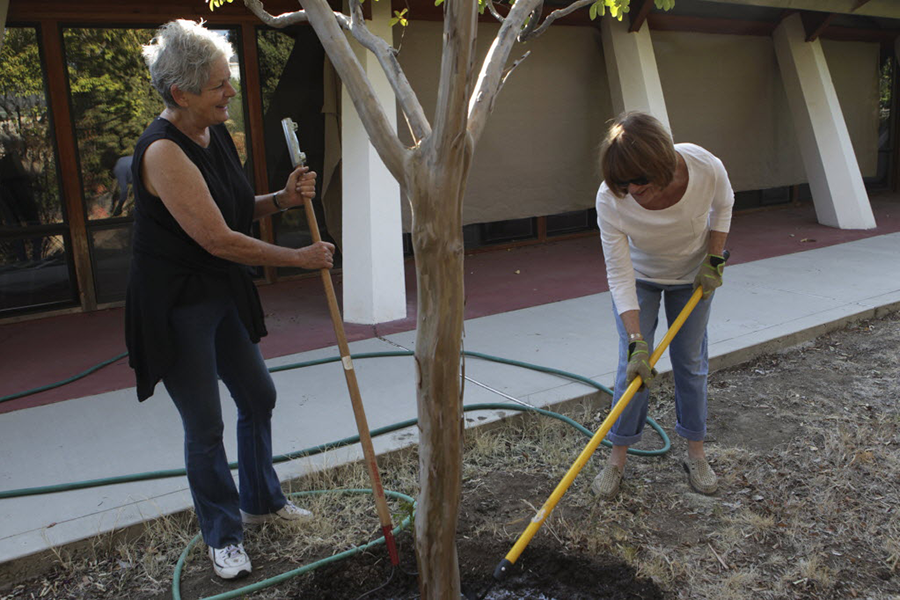California drought: Residents use less water, but is that enough?
Loading...
| Los Angeles
Three years into a historic drought, and in the midst of their state’s driest year on record, Californians are at long last beginning to change their behavior, water analysts say.
The analysts, who say much more needs to be done to conserve California’s water resources, point to two developments this week indicating that state residents are acknowledging the extent of the crisis.
One is data released Tuesday showing that the state reduced its water usage by 7.5 percent in July, a year-over-year savings of 17 billion gallons, according to the State Water Resources Control Board.
The other is a Field Poll published Wednesday indicating that state voters are likely to approve a $7.5 billion water bond – Proposition 1 on the November statewide ballot.
Experts attribute the change to sustained media attention given the drought and more urgent policies enacted by state agencies, including both fines and incentives.
“When you think about 38 million Californians, it sometimes seems like steering a huge oil tanker, but when public policy makers and media finally focus on it, it can finally come together – and has,” says Richard Frank, professor of environmental practice at the University of California, Davis.
“Californian’s can and are using less and are realizing a huge potential to do even more in the future,” says Doug Obegi, the water program staff attorney for the Natural Resources Defense Council. He says his own organization’s polling “shows there is a growing willingness to sacrifice for the drought, from improving efficiency and water recycling to rationing.”
He says the 7.5 percent reduction is significant, even if substantially less than the 20 percent reduction called for by Gov. Jerry Brown upon declaring a state of emergency last Jan. 17.
But Mr. Obegi and others insist residents and agencies can and should do much more.
"While this initial report is an improvement, we hope and trust that it is just a start," Felicia Marcus, the control board's chairwoman, said in a statement.
The reasons for the improvement, Obegi and others say, is increased focus on the drought after three years, media attention, and fines. A bulb-lit freeway sign on the main artery into downtown Los Angeles has notified drivers for months, “Historic drought. Please save water.”
“The state and local water agencies have started to draw a lot more attention to the need to save, and people are realizing a fourth year [of drought] is coming,” Obegi says. “Districts have started sharing more, and some have been fined for wasting water – all this has galvanized a response from the public.”
Prop. 1 includes $2.7 billion for water storage projects, $900 million for groundwater cleanup and monitoring, $725 million for water recycling, and $1.5 billion for watershed restoration programs. Prop. 1 asks voters to approve $7.12 billion in new bond debt and reallocates $425 million in existing unspent bond funds to bring the total spending plan to $7.5 billion.
It is a revised water bond, after legislators voted last month to significantly tweak an $11 billion water bond from 2010 with the scaled-back $7.5 billion version. The larger bond had been criticized for being “pork laden,” including millions of dollars directed to other programs to make it more likely to pass the legislature.
The Field Poll indicated that 52 percent of likely voters said they would vote yes for the water bond, while 27 percent planned to vote no and 21 percent were undecided. Among voters who indicated they were already familiar with the water bond, support was 57 percent in favor and 25 percent against.
Field pollster Mark DiCamillo said that as people learn about the water bond, their support for it increases.
Even though the Field Poll shows a 2-to-1 margin of approval for the bond, Obegi says a win for the measure will take a lot of work.
“I’m cautiously optimistic,” he says. “With lots of work and collective support it could get over the hump, but it will take some effort to educate the voters about what’s at stake here. It’s not going to be a cakewalk.”
The water conservation data indicate a dramatic change in attitude. Despite Governor Brown’s January call for a 20 percent cutback, by June usage actually increased by 1 percent. The state then imposed a mandatory requirement that all 440 of the state’s major water districts implement drought response plans as of Aug. 1.
Many districts took the high-profile and drastic step of imposing $500-a-day fines on residents for hose-washing a car without a shutoff nozzle, overwatering lawns so that runoff floods sidewalks and gutters, using water to clean driveways and sidewalks, and operating fountains without recirculation.
But monetary incentives seem to be helping as well.
The Los Angeles Department of Water and Power recently hiked the rebate for ripping out a lawn and replacing it with drought-tolerant California flora from $2 to $3 per square foot – one of the highest incentive rebates in the state.
“This is having a huge effect,” says Motti Buskila, a horticulturalist who has run his own Sherman Oaks landscape business for 10 years. He says he used to get about 1 or 2 calls per year from those wanting to make the change. Now he has gotten 6 calls in the last six months.
“A major number of people ripping out their urban grass lawns is another example of how a long-standing social behavior is beginning to change in Southern California and across the Southwest,” says UC Davis’ Professor Frank.
“People see other people doing it and have begun to realize the possibilities are much broader than they thought. It’s not just a bunch of gravel and some cactus, “ Buskila says, “but rather a wide variety of really beautiful plants that attract bees and hummingbirds and butterflies.”







